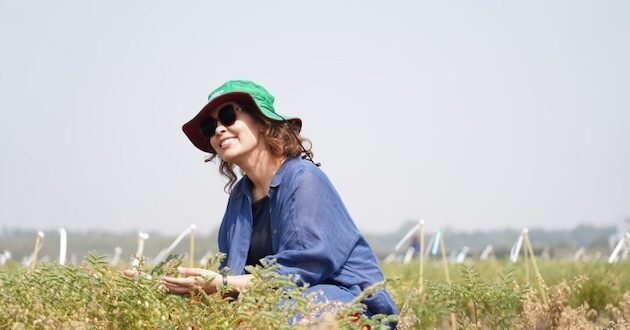
BAKU, Nov 16 (IPS) – As COP29 negotiations continue in Baku, agricultural leaders are pitching the need for climate-resilient and data-driven solutions to support marginalized farmers and low-income communities.
In an exclusive interview with Inter Press Service (IPS), Ismahane Elouafi, Executive Managing Director of the Consortium of International Agricultural Research Centers (CGIAR), discusses the impact of digital tools, precision agriculture, and low-emission food systems on achieving a sustainable and equitable food future.
Inter Press Service: How helpful are digital tools in supporting marginalized farmers?
Ismahane Elouafi: Digital tools offer immense potential, especially in bridging the knowledge gap between agricultural experts and rural farmers who often lack access to information. Over the past few decades, funding for traditional extension services has dwindled, so digital solutions in local languages can fill this void. Imagine a farmer receiving real-time advice on managing water, soil fertility, or disease in a language they understand—this could revolutionize small-scale farming. Additionally, precision agriculture, which tailors input needs to specific locations and soil compositions, allows for highly customized farming strategies that optimize both resources and yields.
IPS: Can you explain how precision agriculture works in practical terms?
Elouafi: Precision agriculture allows us to deliver exact inputs—water, nutrients, or fertilizers—needed for a specific plot. This approach minimizes waste and environmental impact, and it’s especially useful in regions where resources are scarce. For instance, if a plant needs 20 milliliters of water in one square meter but only 10 milliliters a few kilometers away, precision agriculture ensures we don’t overuse resources. Ultimately, the goal is to increase productivity sustainably, producing more output per hectare with fewer inputs, especially in a time where climate pressures demand we be mindful of environmental impacts.
IPS: How essential is biodiversity to resilient farming systems?
Elouafi: Resilience means that after a shock—a drought, flood, or even conflict—farmers can bounce back and continue production. CGIAR’s focus is to provide tools, technology, and genetic resources that make this possible. We’ve developed rice varieties that survive flooding and maize that tolerates drought, helping farmers maintain productivity despite climatic stressors. Another key factor is small-scale irrigation, which allows farmers to respond to drought by providing supplemental water, ensuring resilience and food security.
IPS: You mentioned low-emission food systems. How can agriculture contribute to climate goals?
Elouafi: Agriculture is responsible for about 33 percent of global greenhouse gases. By shifting to low-emission practices, we can greatly reduce methane and other emissions. For example, traditional rice paddies release large amounts of methane. However, alternative wetting and drying practices can cut methane emissions by 30 percent while boosting productivity by 33 percent. In livestock, using specific forages and studying animal gut microbiomes can reduce methane emissions by up to 60 percent. Agriculture is uniquely positioned to sequester carbon through practices like cover cropping and biodiversity, which is crucial in mitigating climate change.
IPS: Could internet and data use enhance climate security?
Elouafi: Absolutely. Digital access and internet coverage in rural areas can provide timely climate information, like rainfall predictions, which empowers farmers to make better planting decisions. With projects like Elon Musk’s nanosatellite network expanding internet access, marginalized farmers can increasingly leverage climate data. CGIAR also focuses on producing accurate data for the Global South, as existing climate models often rely on data from the Global North, which doesn’t reflect realities in places like Sub-Saharan Africa or South Asia. Our data can inform region-specific, actionable climate strategies.
IPS: How does CGIAR support innovations and resilience in vulnerable regions?
Elouafi: CGIAR operates the largest publicly funded international agricultural research network, with a strong focus on least-income countries. Our goal is to close the yield gap between high- and low-income nations by providing bundles of innovations: drought-resistant varieties, small-scale irrigation, processing improvements, and access to markets. By helping farmers integrate these innovations, we ensure they’re more resilient and have a steady income. Additionally, our research helps policymakers design better frameworks to support smallholders and incentivize sustainable agri-food systems.
IPS: What do you hope COP29 will achieve in advancing agricultural and climate agendas?
Elouafi: COP29 must carry forward the momentum from COP28, where the UAE’s Declaration on Sustainable Agri-Food Systems was endorsed by 160 countries. Agriculture, food, and water systems need to be central to climate discussions. As we look to COP30 in Brazil, with its expertise in regenerative and climate-smart agriculture, I hope we continue viewing agriculture not as part of the climate problem but as an essential solution to it. Climate adaptation in agriculture is non-negotiable—lives and livelihoods depend on it.
IPS UN Bureau Report
Follow @IPSNewsUNBureau
Follow IPS News UN Bureau on Instagram
© Inter Press Service (2024) — All Rights ReservedOriginal source: Inter Press Service

